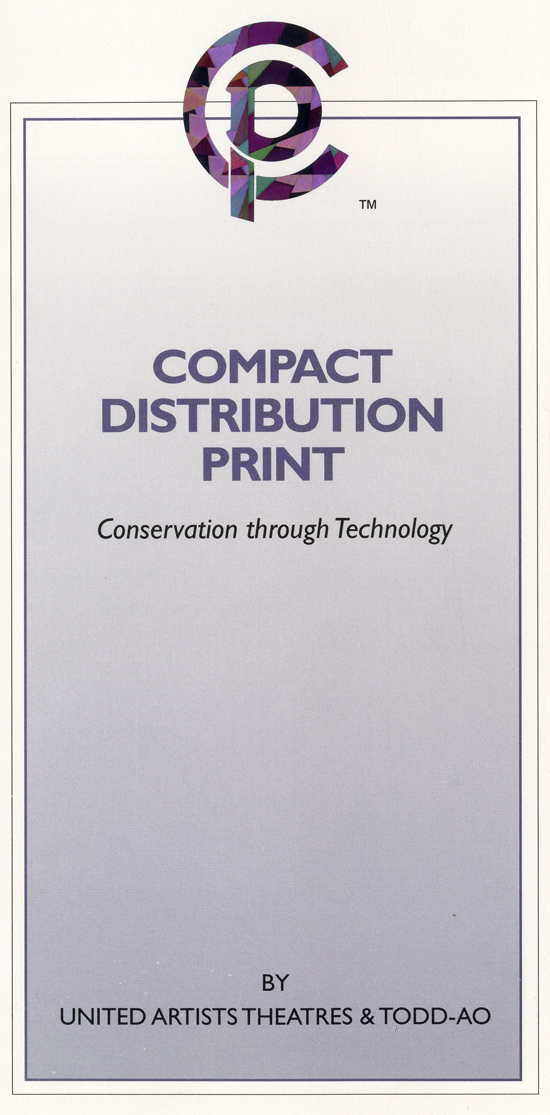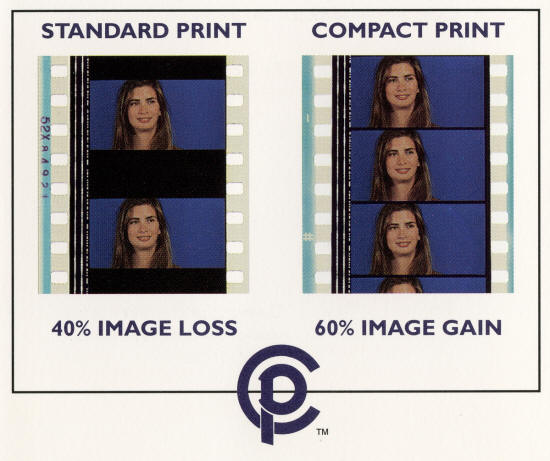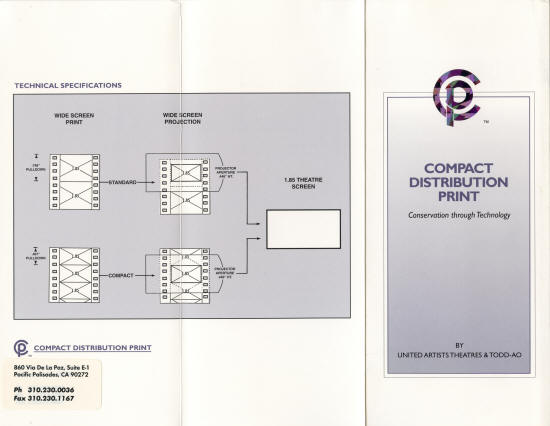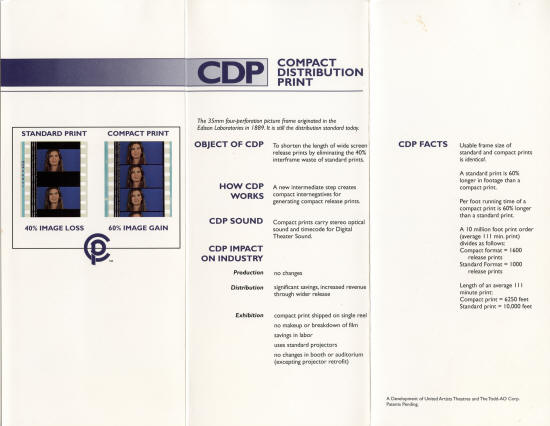|
| |
Compact Distribution Print by Todd-AO
CDP: JUST THE FACTS |
Read more at
in70mm.com
The 70mm Newsletter
|
|
Written by: Dr Richard Vetter, Todd-AO |
Date:
01.01.2020 |
 Some
misleading information has appeared recently in film industry publications
that concerns the Compact Distribution Print, or CDP. Unfortunately, the
quoted sources have not seen CDP demonstrations, so the opinions expressed
are speculation and have no factual basis. The purpose of this brief
article is to state the facts and set the record straight. CDP has been
demonstrated widely, in split-screen comparison, to studio executives, the
creative community, and projection and audio members of SMPTE. A leading
independent testing laboratory evaluated CDP picture and sound performance
in July 1996. Some
misleading information has appeared recently in film industry publications
that concerns the Compact Distribution Print, or CDP. Unfortunately, the
quoted sources have not seen CDP demonstrations, so the opinions expressed
are speculation and have no factual basis. The purpose of this brief
article is to state the facts and set the record straight. CDP has been
demonstrated widely, in split-screen comparison, to studio executives, the
creative community, and projection and audio members of SMPTE. A leading
independent testing laboratory evaluated CDP picture and sound performance
in July 1996.
Fact: All of the original
print-negative information reaches the screen via the compact print
process, and picture and sound performance meets or exceeds current
SMPTE standards.
A summary of the 21-page Evaluation Report
appears here below this text. Fact: All of the original print-negative
information reaches the screen via the compact print process, and picture
and sound performance meets or exceeds current SMPTE standards.
Fact: A compact print is 37.5 percent shorter than a current print. Its
advantages and impact are obvious; they include substantially reduced costs
for film stock, printing, shipping, and handling in the theatre. Also, wider
release of major films becomes possible without affect-ing distribution
budgets.
Fact: The compact print does not affect production or post-production, which
are performed according to standard practice. At the time of release, as is
customary, a standard timed interpositive is made from the completed
production original. From that point forward, the compact print process is
applied.
CDP is a simple three-step process:
• Step 1. Making a compact picture internegative.
• Step 2. Making a compact sound negative.
• Step 3. Making a retrofit to a standard projector.
Let's take those step by step, fact by fact:
1. A compact intenegative is made from a standard timed interpositive.
Fact:
The practical limit of image resolution in original photography is, at
best, 40 line pairs per millimeter (80 lines), and the new resolution limit
using the new Eastman intermediate film (5244) is greater than 130 line
pairs per millimeter (260 lines).
Fact: All of the original negative picture elements (pixels) are re-solved
on the compact print, as confirmed by independent laboratory tests. Step 1
requires new state-of-the-art computer-designed printing lenses compatible with the new high-resolution
intermediate film stock.
Fact: These are the first new computer-designed
printing lenses expressly for the release print-ing process in over a
decade.
Fact: No print will exhibit better quality than the quality of the original
element from which it is derived.
2. A compact sound negative is made from the completed sound master.
Fact:
Sound negative film stock has the capacity to resolve greater than 20 kHz,
although the standard in theatre reproduction is 12.5 kHz.
Fact: Frequency
response of CDP extends from 31.5 Hz to 12.5 kHz, again as confirmed by
independent lab tests. The compact print demonstrates both analog and
digital sound in accordance with SMPTE audio performance standards. 3. A
standard projector is equipped with a new retrofit. permitting projection of
current and compact prints.
Fact: Once the retrofit is made, a projection
attendant can convert from one mode of operation to the other in less than
20 minutes.
Fact: With CDP, picture steadiness is improved and print life
is extended due to the physical dynamics of 56 ft./min. vs. the current 90
ft./min.
COST OF IMPLEMENTATION
Although a final draft of the CDP Business Plan is pending, it appears that
cost of implementation in North America will be recouped within the third
quarter of the first year of majority use of the compact print process.
According to the present business plan, it is not contemplated that
exhibitors will be required to make any investment.
CDP AT 30 FRAMES PER SECOND
Fact: The superiority of a frame rate of 30 per second has been demonstrated
for decades, yet the film industry has been reluctant to financially
embrace it as a new standard
According to the present business
plan, it is not contemplated that exhibitors will be required to make
any investment.
|
More in 70mm reading:
Dr. Richard Vetter about
ClearVision 2000
Dan Leimeter:
Working at Todd-AO Sound Studios
CineSpace
70 / ClearVision 2000 by Todd-AO
|
 Example
of 2˝ perf CDP frames Example
of 2˝ perf CDP frames
Fact: At 30 fps, flicker is eliminated and motion, definition and brightness
are substantially enhanced. It is proposed that CDP can serve as the
catalyst for adopting the higher frame rate.
Fact: At 30 fps, a compact
print is 22 percent shorter than a current print at 24 fps. Presentation of
movies at the elevated frame rate will favorably affect boxoffice revenue
and patron satisfaction.
CONCLUSION
CDP has passed all technical tests and has been awarded numerous U.S. and
foreign pa-tents based on novelty and utility. CDP supports the survival of
film over an electronic alternative. Although CDP has developed a new lamp
condenser lens system for large auditoriums, it does not replace the need
for 70mm prints in ultra-largescreen venues. Wider distribution and superior
presentation coupled with improved economy are what CDP offers the film
industry today.
Historically, there has always been a resistance to change. But the music
industry discovered ways to progress from 78 rpm records to CDs, and
magnetic tape recording has shrunk from 30 ips to 3 3/4 ips and less. Motion
picture film speed has remained, unchanged, at 90 ft./min. for more than 60
years, and the four-perforation format dates to 1889! These standards have
clearly outlived their usefulness. We at United Artists Theatres and Todd-AO
believe it's time for a change for the common good of the film industry and
its valued patrons.
Located in Pacific Palisades, Calif., Dr. Vetter is director of research and
development for United Artists Theatre Circuit and Todd-AO. During his
45-year industry career, he has invented Dimension 150 (a 70mm widescreen
process), Todd-AO's 35mm anamorphic widescreen process (for which the
Academy of Motion Picture Arts and Sciences awarded him a 1973 technical
achievement award), and the Prismalite outdoor screen system. Dr. Vetter,
who is the inventor and patent holder for CDP, has also been involved in the
development of a xenon projection illumination system and various film
systems like StereoSpace 3-D, CineMax 70 and CineCircle 360.
|
|
An Independent U.S. Testing Laboratory
|
|
| Film/Image Test |
Current 4-perf |
Current 2.5 -perf |
| Film resolution
(lines prs/mm) |
68
x 56 |
80
x 126 |
| Screen image (jump
and weave) |
Meets SMPTE Std. Class A |
Meets SMPTE Std. Class A |
| Split-Screen
Comparison |
Increased jump & weave |
Less jump & weave; no screen degradation |
| Film/Perf. life
(1000 passes) |
No
Damage |
No
Damage |
| |
|
|
| Audiop Tests |
|
|
| Frequency response |
31,5 Hz to 12,5 kHz (+/- 1dB) |
31,5 Hz to 12,5 kHz (+/- 1dB) |
| Noise |
No
measureable difference |
No
measureable difference |
| Flutter |
0,10 percent |
0,09 percent |
| Channel separation |
-35
dB |
-36
dB |
| |
|
|
|
|
CDP Flyer
|
|
 Flyer
- press to enlarge Flyer
- press to enlarge
|
|
 Flyer
- press to enlarge Flyer
- press to enlarge
|
|
|
|
|
Go: back - top - back issues - news index
Updated
28-07-24 |
|
|
 Some
misleading information has appeared recently in film industry publications
that concerns the Compact Distribution Print, or CDP. Unfortunately, the
quoted sources have not seen CDP demonstrations, so the opinions expressed
are speculation and have no factual basis. The purpose of this brief
article is to state the facts and set the record straight. CDP has been
demonstrated widely, in split-screen comparison, to studio executives, the
creative community, and projection and audio members of SMPTE. A leading
independent testing laboratory evaluated CDP picture and sound performance
in July 1996.
Some
misleading information has appeared recently in film industry publications
that concerns the Compact Distribution Print, or CDP. Unfortunately, the
quoted sources have not seen CDP demonstrations, so the opinions expressed
are speculation and have no factual basis. The purpose of this brief
article is to state the facts and set the record straight. CDP has been
demonstrated widely, in split-screen comparison, to studio executives, the
creative community, and projection and audio members of SMPTE. A leading
independent testing laboratory evaluated CDP picture and sound performance
in July 1996.
 Example
of 2˝ perf CDP frames
Example
of 2˝ perf CDP frames Flyer
- press to enlarge
Flyer
- press to enlarge Flyer
- press to enlarge
Flyer
- press to enlarge